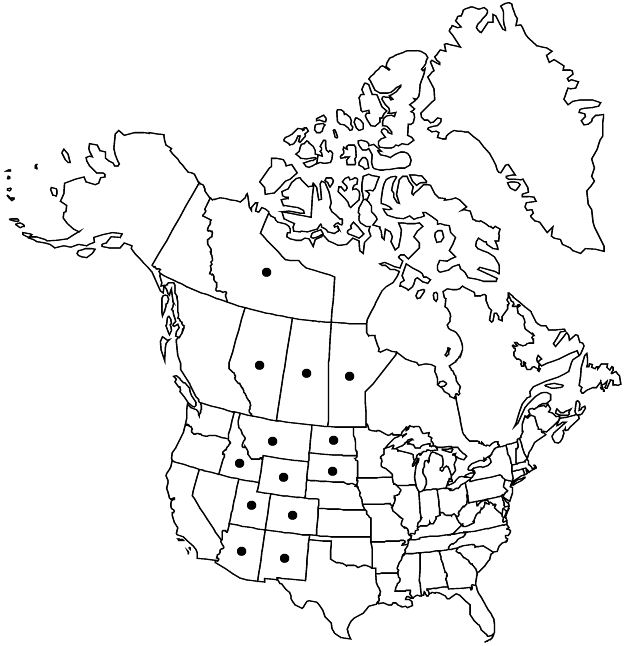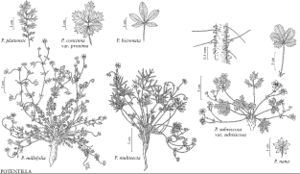Potentilla plattensis
in J. Torrey and A. Gray, Fl. N. Amer. 1: 439. 1840.
Plants rosetted to tufted; taproots fleshy-thickened. Stems initially decumbent to sometimes ascending, becoming prostrate or supported by vegetation, (0.3–)0.5–3.5(–4.5) dm, lengths 1.5–2.5(–4) times basal leaves. Basal leaves pinnate with distal leaflets ± distinct, 2–15(–20) × 1–3 cm; petiole 0.5–5 cm, straight hairs common, tightly appressed, 0.5(–1) mm, stiff, cottony hairs absent, glands absent or sparse; primary lateral leaflets (3–)4–6(–8) per side, on distal (1/4–)1/2–3/4 of leaf axis, overlapping to separate, largest ones obovate, 0.5–1.5(–2) × 0.5–1(–1.3) cm, distal (1/2–)2/3 to whole margin pinnately incised 3/4+ to midvein, ultimate teeth 5–10, linear-oblanceolate, 1.5–8(–10) × 1–2 mm, apical tufts less than 0.5 mm, surfaces green to grayish green, not glaucous, straight hairs sparse to common (sparser adaxially), tightly appressed, 0.5 mm, stiff, cottony hairs absent, glands absent or inconspicuous. Cauline leaves 1–3. Inflorescences (1–)3–15(–20)-flowered, loosely cymose, sometimes racemiform. Pedicels 1–4(–5) cm, ± recurved in fruit. Flowers: epicalyx bractlets narrowly elliptic to linear-lanceolate, 2–5(–6) × 0.5–2 mm; hypanthium 3–4 mm diam.; sepals 3–6 mm, apex acute; petals 4–7 × 3–6 mm; filaments 1–2.5 mm, anthers 0.5–1 mm, usually ± 1/2 as long as filaments; carpels 10–20, styles 1.5–2.5 mm. Achenes (1.3–)1.5–1.9 mm, smooth, often ± carunculate. 2n = 70.
Phenology: Flowering summer.
Habitat: Moist meadows, streamsides, reservoir margins
Elevation: 300–2900 m
Distribution

Alta., Man., N.W.T., Sask., Ariz., Colo., Idaho, Mont., N.Mex., N.Dak., S.Dak., Utah, Wyo.
Discussion
Potentilla plattensis occurs mostly east of the Continental Divide from the Canadian Prairies to the mountains of New Mexico. The species barely enters Idaho at Monida Pass (Clark County). Populations also exist in the White Mountains of east-central Arizona and the mountains of southern Utah. The species is relatively uniform throughout its range but there is often significant seasonal variation, such that plants can be compact and densely strigose in early summer but elongate and subglabrous later in the season.
Where the ranges of Potentilla plattensis and P. ovina overlap, the two are sometimes difficult to distinguish. The habitats are usually distinct, in that P. plattensis generally occurs in moist valley bottoms and P. ovina occurs in rocky uplands. Differences in vestiture are also diagnostic: hairs of P. plattensis are 0.5 mm and tightly appressed; those of P. ovina are longer and looser.
Selected References
None.
